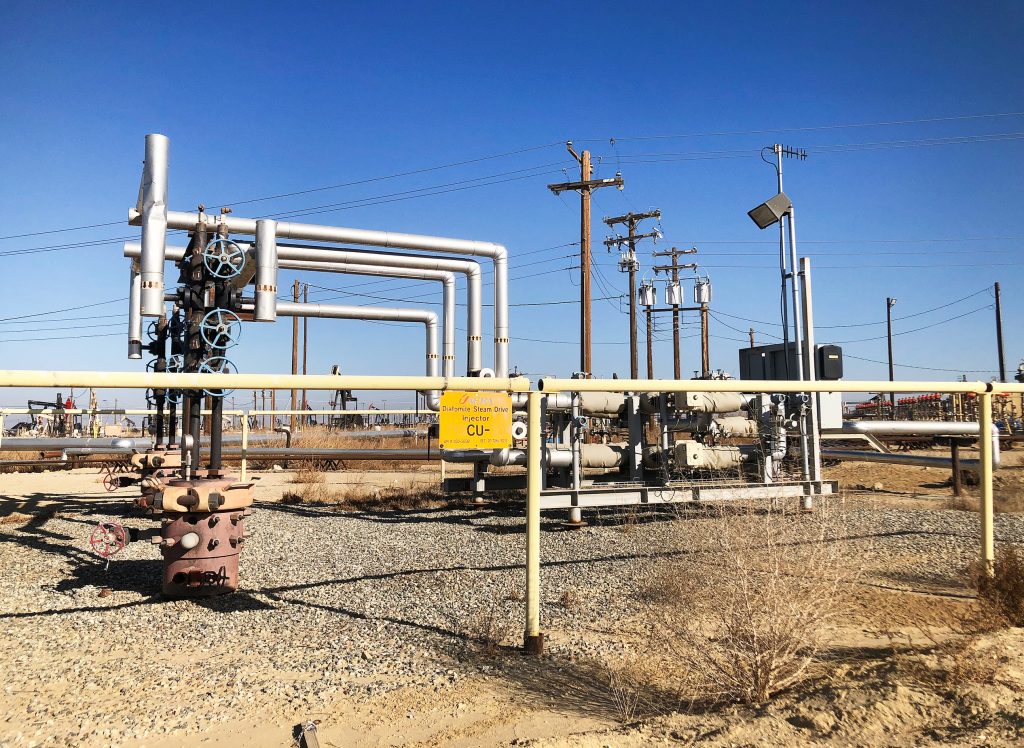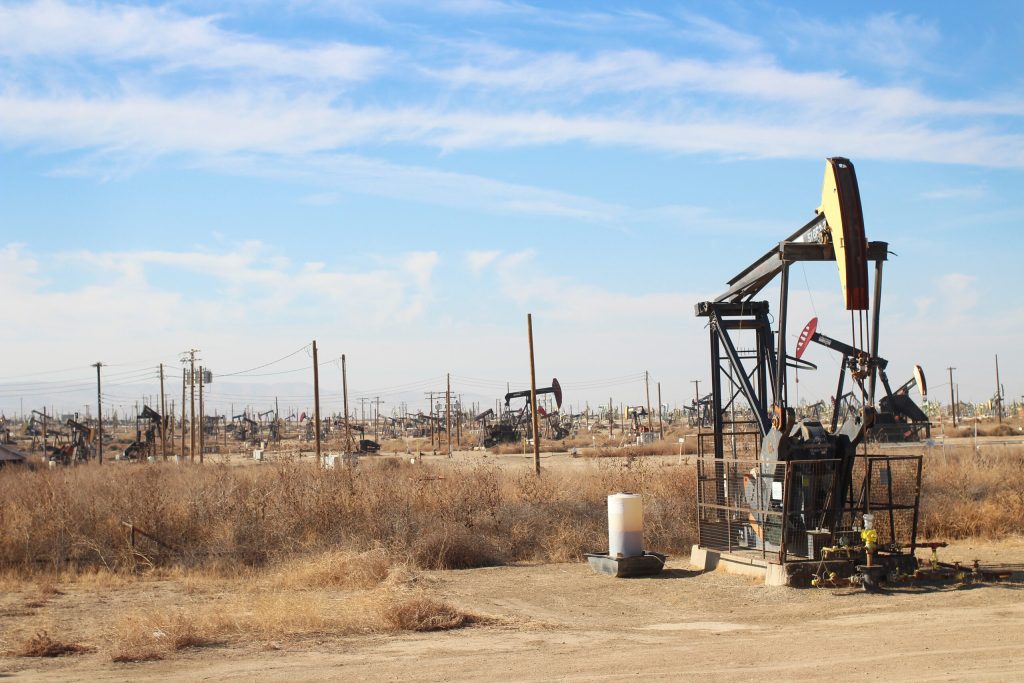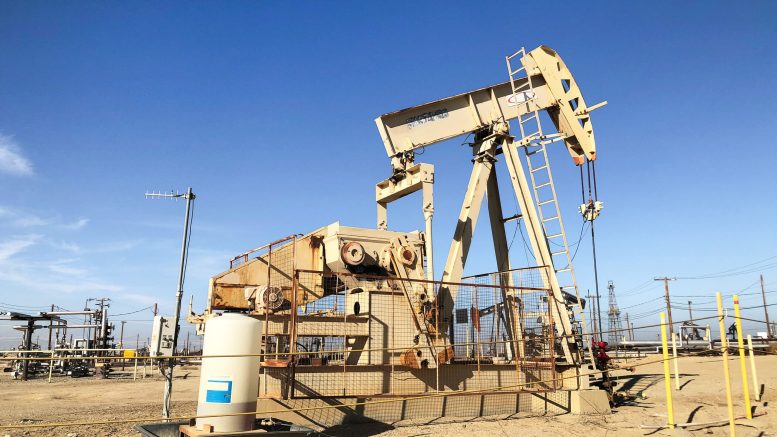A new state law mandates that oil companies put up money to plug wells before acquiring them. It could fail its first big test, putting taxpayers on the hook.
By Aaron Cantú, Capital & Main
This story is produced by the award-winning journalism nonprofit Capital & Main and co-published here with permission.
In recent years, California has passed new laws to tackle the enormously expensive remediation of old oil wells, which pose hazards for human health and the climate. But as two of the state’s largest oil well operators race toward a corporate merger, the challenge of holding companies accountable for their mess is coming into view.
Gov. Gavin Newsom signed one of the state’s toughest regulations last fall: a law requiring companies that buy or acquire another operator’s oil wells to put up the money to plug them once they run dry. But California Resources Corporation — which plans to acquire Aera Energy — is refusing to say whether it has complied, or will comply.
California Resources Corporation did not respond to inquiries for this story.
In emails with the regulator, the company stated there would be “no change in the organizational structure” of Aera, which operates the wells California Resources Corporation wants to acquire.
The law states that the acquisition cannot be completed until the state calculates the size of the bond that the operator must secure. The law is also clear that operators such as California Resources Corporation must ask the state to begin calculating the size of the bond, which the company does not appear to have done, said Ann Alexander, director of Energy Solutions, Nature at the Natural Resources Defense Council, which advocated for the law.
Given that the proposed merger is set for a June 26 shareholders vote — one of the main conditions for the transaction — it is “quite unlikely” California Resources Corporation has requested bond estimates from the state, Alexander said.
“There are a really large number of wells here,” Alexander said. Estimating the bond amounts for the thousands of wells is “a process that’s going to take a significant amount of time” — likely a few months.
Meanwhile, the California Geologic Energy Management Division, the state agency that oversees the 100,000 or so active and idle wells that dot California’s landscape, declined to say whether the company requested a bond amount or communicated about the bonding requirements at all.
Insufficient bonds could ultimately cost taxpayers billions when it comes time to plug the roughly 37,000 wells that will be in the company’s portfolio after the planned merger.
The bonding requirement law mandates that before any acquisition of wells, a company must put up enough money to ensure that low-producing oil wells are plugged. Plugging the wells is necessary to prevent climate-warming methane gas from escaping into the atmosphere. Fossil fuels such as methane are the main driver of the ongoing climate crisis.

In filings with the Securities and Exchange Commission, California Resources Corporation estimated that after acquiring Aera, its long-term financial obligations for plugging its old wells and decommissioning related equipment would amount to $1 billion.
But that’s likely billions less than it will actually cost.
The Sierra Club last year estimated that the cost to clean up just the portion of California Resources Corporation’s and Aera’s wells that are no longer in production would cost $3.5 billion. If the active wells were included too, the cost would be billions more.
“It’s quite frustrating to those of us who have worked very hard to try and help California dig out of the colossal mess that it is in” with unplugged wells, said Alexander.
The law arrived last year as Assembly Bill 1167, introduced by Assemblymember Wendy Carrillo (D-Los Angeles), who saw it as a way to put the financial burden of ending the lives of old oil wells on the operators, not the taxpayers.
In a letter to the California Geologic Energy Management Division, Carrillo and other lawmakers urged regulators to enforce the law, saying it presented an opportunity to ensure companies do not foist the costs of capping idle and marginal wells onto taxpayers.
“This merger is precisely the sort of transaction that AB 1167 was designed to address,” the letter states.
Carrillo’s staff declined to make her available for an interview, instead directing questions to the Natural Resources Defense Council, and emailing a statement.
In a text message forwarded by a staffer, Carrillo said nobody “knows for certain at the moment what CalGEM’s plans are as to enforcing AB 1167 in this merger. But the magnitude of the risk the merger creates for California and its taxpayers makes it critical in my view that CalGEM reassure the public that they intend to enforce the law.”
The law states that any entity that “acquires the right to operate” a low-producing or idle well must put up a bond before completing the acquisition. The law states that the state oil and gas supervisor, not the oil operator, will calculate the amount of the bond. The bill also states that the acquisition cannot be completed until the state calculates the size of the bond that the operator must secure.
The vast majority of the oil wells in California, including those owned by California Resources Corporation and Aera, are low producing, meaning that they are nearing the end of their lives and will soon need to be plugged. A low-producing well is defined as one that produces 15 or few barrels of oil a day. Aera’s active wells produce, on average, just enough to fill the tanks of 10 cars.
Asked by Capital & Main whether the agency believes AB 1167 applies in the California Resources Corporation and Aera merger, Jacob Roper, a spokesman for the California Department of Conservation, said that the agency issued regulatory guidelines to all oil companies in the state before the law went into effect.
He repeated that the law states “to the extent that wells or facilities are transferred between entities, the law puts the responsibility on operators to notify the Department of Conservation and request a cost estimate if AB 1167 applies.”
Roper would not say whether AB 1167 would apply to California Resources Corporation’s merger with Aera, or if California Resources Corporation had requested a bond estimate. “That’s all we have to share at this time,” he said.
California Resources Corporation did not respond to inquiries for this story. But in a February email to regulators, obtained by Capital & Main, the company said, “There will be no change in the organizational structure of Aera Energy LLC or its operating subsidiaries as a result of this transaction.”
After the merger, Aera would remain the operator of its wells even though it would be owned by California Resources Corporation. The latter argues that no wells are actually changing hands.
Climate activists worry that the sheer size of the merger could be a significant problem as well if the state doesn’t force California Resources Corporation to put up a bond big enough to cover cleanup costs.
If the merger goes through, the company will own roughly 40% of all unplugged oil wells in California, many in the lower Central Valley. By wide margins, it would be the largest oil well owner in California. Were the firm to cease operations without adequate bond protection, the burden could fall to taxpayers — and industry watchers say the company has a concerning track record in this regard.

California Resources Corporation filed for bankruptcy in 2020, allowing it to wipe $4.4 billion in debt from its books. The company was saddled with the debt after it was spun off from Occidental Petroleum, which left the state years ago without plugging its old wells.
Alexander, the Natural Resources Defense Council director, said the merger would result in putting “a colossal number of eggs in the same basket. This is creating an entity that is too big to fail,” meaning if it did fail and there was not a bond big enough to pay for cleanup, the financial fallout for the public could be immense.
During a meeting with shareholders in February announcing the merger, California Resources Corporation CEO and President Francisco Leon said the merger would “more than double” the company’s cash after operating expenses.
The No. 1 priority of that increased cash flow, he said, will be “to enhance shareholder returns.” Yet across California’s oil and gas producing industry, most of the remaining proceeds from production will be earned before 2026, after which “the liability of taxpayers will be that much greater,” according to a report by the Carbon Tracker Initiative, a London-based think tank.
Even if every dollar generated by oil companies in California was squirreled away to pay for cleanup, it is unlikely the industry “will generate enough cash flow in its remaining economic life to fund its current decommissioning obligations,” Carbon Tracker found.
As of December, those obligations for all oil and gas producers statewide totaled $22.9 billion.
Copyright 2024 Capital & Main.
All photos by Aaron Cantú.
This story has been updated to include a statement from Assemblymember Wendy Carrillo.


Be the first to comment on "Will California’s largest oil well owner get a pass on paying to clean up Its mess?"